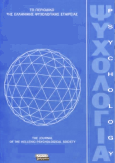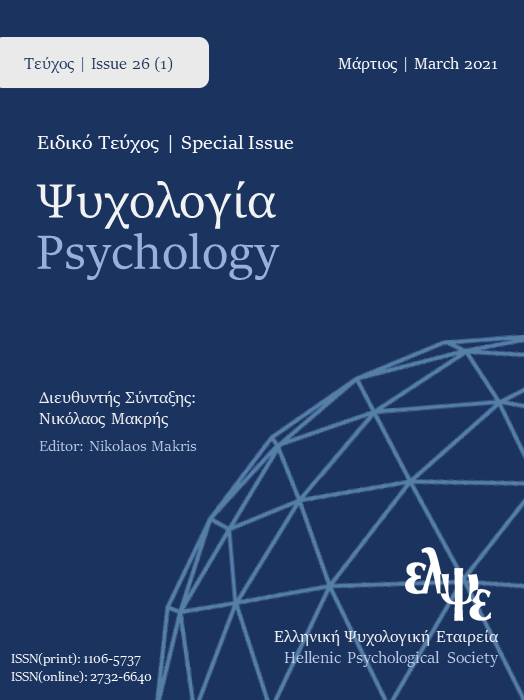Η σημασία των χρόνων απόκρισης σε τρεις δοκιμασίες λεκτικής ευχέρειας

Περίληψη
Οι δοκιμασίες λεκτικής ευχέρειας αποτελούν συχνά χρησιμοποιούμενα εργαλεία νευροψυχολογικής αξιολόγησης, τόσο σε κλινικούς πληθυσμούς, όσο και στην έρευνα. Ως λεκτική ευχέρεια ορίζεται η δυνατότητα ενός ατόμου να παράγει λέξεις μιας ζητούμενης κατηγορίας σε προκαθορισμένο χρόνο. Στις δοκιμασίες, συνήθως, συμπεριλαμβάνονται 2 τύποι λεκτικής ευχέρειας, η φωνημική και η σημασιολογική, οι οποίες εξετάζουν διαφορετικές λεκτικές ικανότητες και εκτελεστικές λειτουργίες. Στην παρούσα έρευνα εξετάσαμε τους χρόνους απόκρισης της πρώτης λέξης 3 δοκιμασιών λεκτικής ευχέρειας (φωνημική, σημασιολογική και ευχέρεια αποκλειόμενου γράμματος) ως ένα επιπρόσθετο μέτρο αξιολόγησης, σε δείγμα 44 υγιών ενηλίκων ηλικίας 18 έως 39 ετών, οι οποίοι χωρίστηκαν σε 2 ισάριθμες ομάδες βάσει της εκπαίδευσης τους. Επιπλέον, διερευνήσαμε την πιθανή επίδραση του εκπαιδευτικού επιπέδου στους μέσους χρόνους απόκρισης σε αυτές τις δοκιμασίες. Η σύγκριση των χρόνων απόκρισης των 3 δοκιμασιών, υπέδειξε ότι η σημασιολογική ευχέρεια διαθέτει τους μικρότερους χρόνους απόκρισης, ενώ η ευχέρεια αποκλειόμενου γράμματος τους μεγαλύτερους (Z = -5.35, p < 0.0005). Τα αποτελέσματα του δεύτερου σκέλους της ανάλυσης υπέδειξαν την στατιστικά σημαντική επιρροή της εκπαίδευσης στους μέσους χρόνους απόκρισης των συμμετεχόντων ( U = 137, p = 0.014; U = 141.5, p = 0.018; t = 2.05, p = 0.046). Τα αποτελέσματα αυτά συνιστούν έναν καινούργιο τρόπο διερεύνησης της λεξιλογικής πρόσβασης στην λεκτική ευχέρεια και υποδεικνύουν πως οι χρόνοι απόκρισης στις δοκιμασίες ανάκλησης λέξεων βάσει του αρχικού τους γράμματος διαφέρουν σημαντικά από τους χρόνους απόκρισης κατά την ανάκληση λέξεων βάσει σημασιολογικών κριτηρίων. Παράλληλα, επισημαίνεται η σημαντική επιρροή της εκπαίδευσης, όχι μόνο στην συνολική επίδοση των συμμετεχόντων, αλλά και σε αυτό το επιπρόσθετο μέτρο αξιολόγησης.
Λεπτομέρειες άρθρου
- Πώς να δημιουργήσετε Αναφορές
-
Ωρολογά Α., Χατζόπουλος Γ., Νικολαΐδης Δ., Κοσμίδου Μ.-Ε., & Πρωΐου Χ. (2024). Η σημασία των χρόνων απόκρισης σε τρεις δοκιμασίες λεκτικής ευχέρειας. Ψυχολογία: το περιοδικό της Ελληνικής Ψυχολογικής Εταιρείας, 29(1), 71–81. https://doi.org/10.12681/psy_hps.34095
- Ενότητα
- ΕΜΠΕΙΡΙΚΕΣ ΕΡΓΑΣΙΕΣ

Αυτή η εργασία είναι αδειοδοτημένη υπό το Creative Commons Attribution-ShareAlike 4.0 International License.
Το περιοδικό ΨΥΧΟΛΟΓΙΑ έχει υιοθετήσει μία πολιτική Platinum open-access. Τα έξοδα υποβολής, επεξεργασίας ή δημοσίευσης των εργασιών καλύπτονται από την Ελληνική Ψυχολογική Εταιρεία. Τα πνευματικά δικαιώματα των δημοσιευμένων εργασιών προστατεύονται από την άδεια 'Creative Commons Attribution-ShareAlike 4.0 International'. Οι Συγγραφείς διατηρούν τα Πνευματικά Δικαιώματα και χορηγούν στο περιοδικό το δικαίωμα της πρώτης δημοσίευσης. Η άδεια αυτή επιτρέπει σε τρίτους, να χρησιμοποιούν την εργασία σε οποιαδήποτε μορφή, με την προϋπόθεση της διατήρησης των διατυπώσεων που προβλέπονται στην άδεια σχετικά με την αναφορά στον αρχικό δημιουργό και την αρχική δημοσίευση στο περιοδικό ΨΥΧΟΛΟΓΙΑ. Επιπλέον, κάθε διανομή της εργασίας οφείλει να γίνεται με τους ίδιους όρους διανομής, δηλαδή με την ίδια άδεια Creative Commons.





